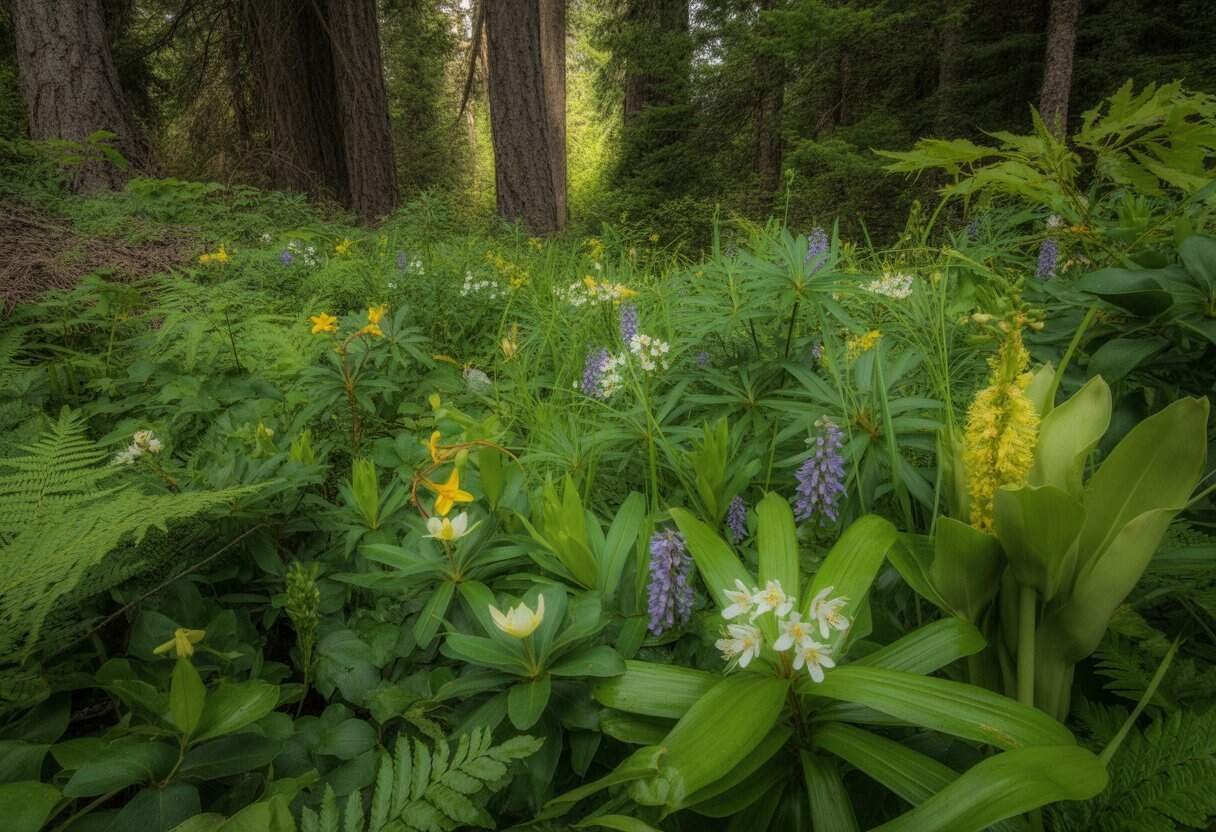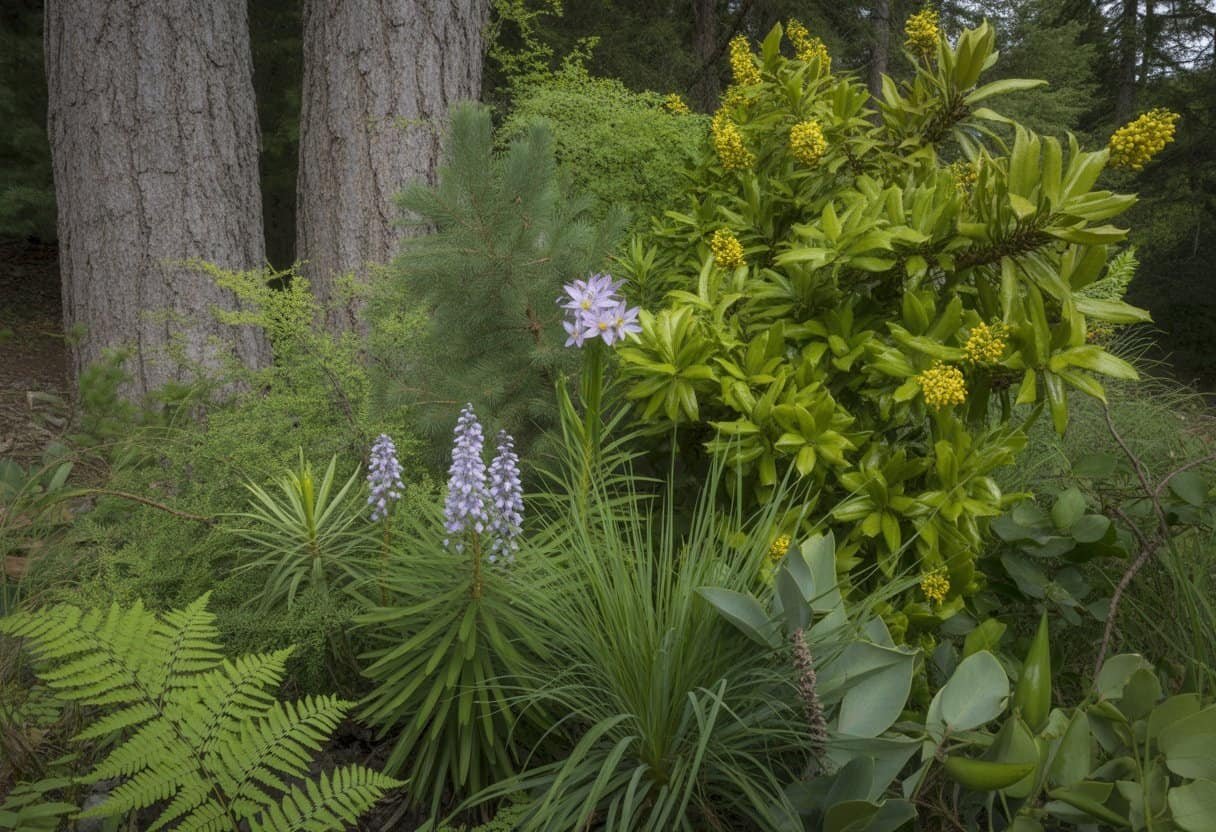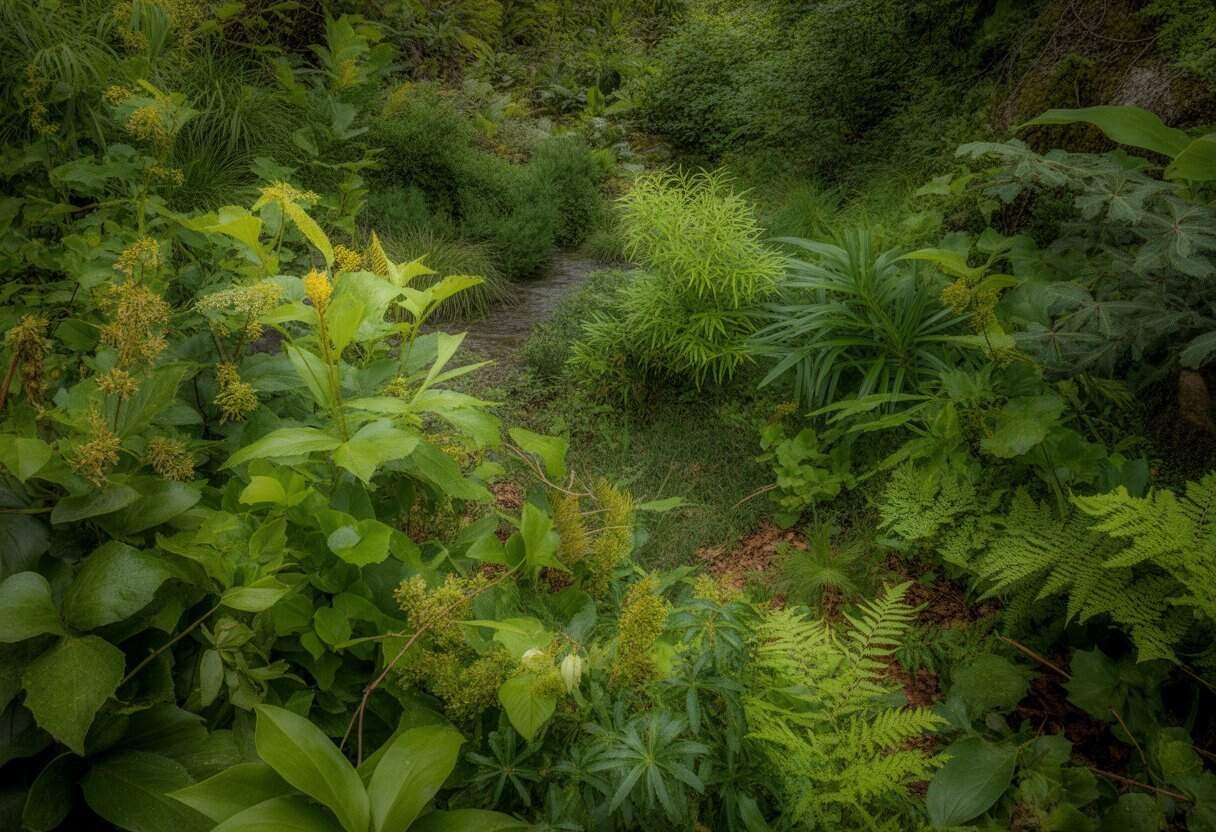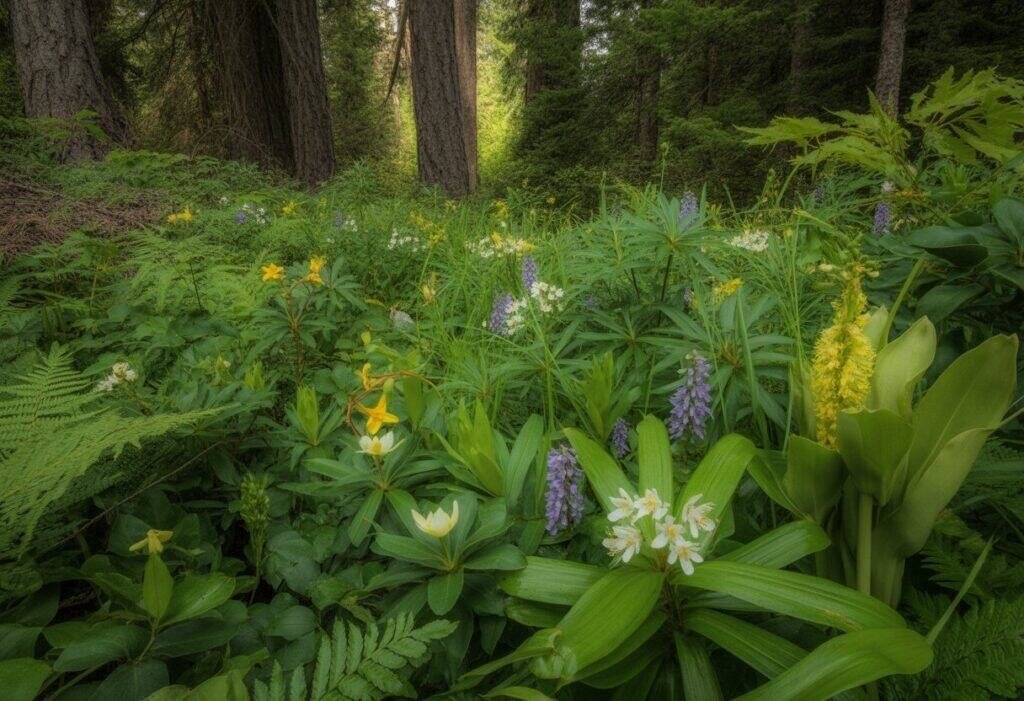Oregon is home to an incredible diversity of native plants, adapted to the region’s varied climates and landscapes. From the coastal regions to the high desert, these plants have evolved over thousands of years to thrive in local conditions without extra water or fertilizer.
Growing Oregon native plants in your garden supports local ecosystems, conserves water, and creates habitat for native wildlife like birds, butterflies, and beneficial insects.

Native plants connect us to Oregon’s natural heritage and offer practical benefits for gardeners. They typically require less maintenance once established and can withstand regional weather extremes better than non-native species.
The Pacific Northwest’s unique growing conditions have created specialized plant communities. These communities showcase the region’s botanical richness.
Key Takeaways
- Oregon native plants require less water and maintenance while supporting local wildlife and pollinators.
- Native plant options exist for every garden setting, from shady woodland areas to sunny, drought-prone locations.
- Using regional native plants preserves Oregon’s botanical heritage and helps create more sustainable, resilient landscapes.
What Are Oregon Native Plants?
Native plants are species that have evolved and adapted to Oregon’s diverse landscapes over thousands of years. These plants form the foundation of local ecosystems and provide many benefits to wildlife and people.
Definition and Characteristics
Oregon native plants are species that naturally occurred in the region before European settlement. They evolved alongside local wildlife, developing mutual relationships that support the ecosystem.
Native plants vary widely across Oregon’s regions. In the coastal areas, shore pines and salal thrive in sandy, windy conditions.
The Willamette Valley hosts beautiful camas lilies and Oregon white oak. Eastern Oregon features drought-resistant sagebrush and juniper trees.
These plants are perfectly adapted to local rainfall, soil, and temperature ranges. This means they generally require less water, fertilizer, and maintenance once established.
Many Oregon natives display striking seasonal changes. Red-osier dogwood shows bright red stems in winter, while Oregon grape provides yellow flowers in spring and blue berries in summer.
Benefits of Native Species
Oregon native plants deliver significant advantages to gardens and wild spaces. They require minimal maintenance after establishment, saving time, water, and money.
Most natives don’t need fertilizers or pesticides to thrive. These plants provide essential habitat for local wildlife.
Native Douglas fir trees support over 300 species of insects, which feed birds and other animals. Pollinators like bees and butterflies depend on native flowers they’ve evolved with.
Native plants help prevent erosion with deep root systems that hold soil in place. They filter water runoff and improve soil health through natural processes.
Using natives in landscaping creates a sense of place that connects gardens to Oregon’s natural heritage. Plants like Pacific dogwood, trillium, and sword fern bring authentic Northwest character to any landscape.
Major Types of Oregon Native Plants

Oregon’s landscapes support a rich variety of native plants adapted to the state’s unique growing conditions. These plants thrive in local soils and weather patterns while providing habitat for wildlife.
Oregon Native Flowers
Oregon’s native flowers add color and beauty to gardens while helping local pollinators. Camas, with blue-purple blooms, once covered the Willamette Valley in spring and remains culturally significant to Indigenous peoples.
The Inside-out Flower (Vancouveria) thrives in woodlands with unusual white blossoms that appear turned inside out. Western Bleeding Heart displays heart-shaped pink flowers on arching stems in shady forests.
Showy Milkweed (Asclepias speciosa) produces clusters of star-shaped pink flowers that attract monarch butterflies. This plant serves as the sole food source for monarch caterpillars.
Stream Violet creates carpets of small purple flowers in moist areas, often near water. These natives spread gently and bloom in early spring.
Native Shrubs and Small Trees
Vine Maple (Acer circinatum) offers brilliant fall color and grows well in both sun and shade. Its compact size makes it perfect for smaller gardens or as an understory tree.
Red Flowering Currant bursts with pink blossoms in early spring, providing nectar for hummingbirds. This drought-tolerant shrub reaches 6-10 feet tall.
Evergreen Huckleberry maintains year-round foliage with small, glossy leaves. It produces edible dark berries favored by birds and people.
Woods Rose and Mock Orange add fragrance to native gardens. The simple pink roses appear in summer, while Mock Orange produces intensely scented white blooms.
Tall Oregon Grape features holly-like evergreen leaves and bright yellow flowers followed by blue berries. It works well as a natural barrier or privacy screen.
Native Groundcovers and Ferns
Low-growing native plants create living mulch that suppresses weeds and protects soil. Kinnikinnick (Arctostaphylos uva-ursi) forms dense mats of small, glossy leaves with tiny pink flowers and red berries.
Douglas Spirea creates drifts of pink flowers in summer, attracting butterflies. This plant handles both wet and dry conditions once established.
Sword ferns provide year-round structure with their arching fronds. These evergreens thrive in woodlands and require little maintenance.
Thimbleberry offers soft maple-like leaves and white flowers followed by edible red berries. It spreads to form colonies in partial shade and helps stabilize slopes.
These groundcovers connect garden spaces visually while providing habitat for insects and small wildlife.
Best Native Plants for Oregon Gardens
Oregon native plants offer gardeners beautiful, low-maintenance options that support local ecosystems. These plants have adapted to Oregon’s environments over thousands of years, making them great additions to home landscapes.
Top Choices for Home Landscapes
Oregon Grape (Mahonia aquifolium) stands out as an excellent native shrub with year-round appeal. Its bright yellow flowers in spring attract pollinators, while its blue-purple berries feed birds in fall.
This evergreen plant requires little maintenance and tolerates shade well. Blueblossom (Ceanothus thyrsiflorus) creates stunning blue flower displays and works well in sunny, drought-prone areas.
Western Serviceberry (Amelanchier alnifolia) offers white spring flowers, edible purple berries, and vibrant fall foliage. It grows 6-15 feet tall and fits well as a specimen plant or in mixed borders.
Wild Ginger (Asarum caudatum) provides excellent groundcover for shady areas. Its heart-shaped leaves create a lush carpet, while its unusual flowers appear at ground level.
Native Plants for Pollinators
Douglas Spirea (Spiraea douglasii) attracts butterflies with its pink flower clusters. This shrub thrives in both wet and dry conditions.
Goldenrod (Solidago canadensis) brings late-season color and supports bees when many other plants have finished blooming. It does not cause hay fever and fits well in pollinator gardens.
Red Flowering Currant (Ribes sanguineum) draws hummingbirds with bright pink-red blossoms in early spring. This deciduous shrub grows 5-10 feet tall and performs well in partial shade to full sun.
Pearly Everlasting (Anaphalis margaritacea) attracts butterflies, especially American Painted Ladies, which use it as a host plant. Its silver-gray foliage and white flowers add texture to the garden.
Edible and Medicinal Varieties
Salal (Gaultheria shallon) produces sweet, dark purple berries for fresh eating or jams. This evergreen shrub grows well in woodlands and partial shade.
Evergreen Huckleberry (Vaccinium ovatum) yields delicious berries similar to blueberries. It grows 3-8 feet tall and makes an attractive hedge while providing food for wildlife and people.
Yarrow (Achillea millefolium) has been used medicinally to treat wounds and reduce inflammation. Its feathery foliage and flat-topped white flower clusters add texture to gardens.
Wild Strawberry (Fragaria virginiana) spreads to form a low groundcover with edible berries. It grows best in full sun to light shade.
Ecological Importance of Native Plants

Oregon’s native plants form the backbone of local ecosystems. They provide crucial support for wildlife and maintain ecological balance.
These plants have evolved alongside other organisms over thousands of years. Their interdependent relationships sustain the health of natural areas.
Wildlife Habitat and Biodiversity
Native plants create essential habitat for Oregon’s wildlife. Unlike non-native plants, these species provide the right type of food, shelter, and nesting materials that local wildlife depends on.
Birds rely on native plants for berries, seeds, and the insects they attract. For example, the Oregon White Oak supports over 200 species of wildlife, including birds like acorn woodpeckers and western bluebirds.
Native shrubs like Red-flowering Currant and Salal provide dense cover that protects small mammals from predators. These plants also produce fruits that feed many animals through different seasons.
Endangered species often have specific relationships with native plants. The Oregon Silverspot butterfly can only lay eggs on the native Western Blue Violet.
Support for Insects and Pollinators
Native plants and local insects share a special relationship built over centuries of evolution. Bees, butterflies, and other pollinators depend on native flowering plants for nectar and pollen.
Oregon’s native Camas Lily provides early-season food for bumble bees emerging from winter hibernation. Native plant gardens support four times more beneficial insects than gardens with non-native plants.
This includes important pollinators that help produce many foods we eat. Caterpillars, which later become butterflies, often can only eat specific native plants.
The larvae of Oregon’s Fender’s Blue butterfly feed exclusively on Kincaid’s Lupine, a threatened native plant. Healthy insect populations supported by native plants create a foundation for the entire food web, feeding birds, bats, and other wildlife throughout Oregon’s ecosystems.
Regional Diversity of Native Plants in Oregon
Oregon’s diverse landscapes create distinct plant communities across the state. Native plants have adapted to specific regional conditions, resulting in remarkable biodiversity from the coast to the high desert.
Willamette Valley Natives
The Willamette Valley hosts a unique collection of native plants adapted to its mild, wet winters and warm, dry summers. Oregon white oak dominates this region, creating woodland habitats for understory plants like camas lily and fawn lily.
Prairie plants thrive in the valley’s open spaces. Wildflowers such as Oregon sunshine and checker mallow add vibrant colors to meadows during spring and summer.
Wetland areas support water-loving species including wapato and Oregon ash. These plants play roles in filtering water and providing wildlife habitat.
Native shrubs like Oregon grape, salal, and red-flowering currant offer food for local birds and pollinators. These plants adapt well to both natural settings and home gardens.
Native Plants of Western Oregon
Western Oregon’s coastal regions feature salt-tolerant natives like beach strawberry and seashore lupine. These hardy plants withstand strong winds and sandy soils.
The Coast Range supports diverse conifer forests. Western hemlock, Sitka spruce, and Douglas fir create the iconic evergreen canopy here.
Understory plants in these forests include sword fern, salal, and Oregon oxalis. These shade-tolerant species have adapted to life beneath the forest canopy.
Riparian areas along rivers contain red alder, Oregon ash, and various willows. These trees stabilize streambanks and provide cooling shade for salmon-bearing streams.
Mountain regions host subalpine species like beargrass and alpine lilies. These plants have short growing seasons and produce spectacular blooms during summer.
Planting and Caring for Oregon Native Plants
Growing native plants from Oregon in your garden creates a beautiful landscape and supports local ecosystems. These plants have adapted to the region’s conditions over thousands of years.
Choosing the Right Plant
Native plants thrive when placed in conditions similar to their natural habitats. Consider your garden’s microclimate before selecting plants.
Match bloom times to ensure year-round interest. Early bloomers like Red-flowering Currant provide spring color, while Camas and Oregon Iris add summer beauty.
Choose plants that match your garden’s purpose. For wildlife gardens, select Oregon Grape and Serviceberry for their bird-friendly berries. For drought-prone areas, use Kinnikinnick and Idaho Fescue.
Many native plant nurseries in Oregon offer locally sourced plants. These specialists can guide you on species suited to your garden.
Soil Conditions and Sunlight
Oregon’s landscapes create varied soil types across the state. Western valleys usually have rich, fertile soil while eastern regions are drier and sandier.
Most native plants prefer well-draining soil. Add compost to heavy clay soils to improve drainage.
For woodland plants like Trillium, add leaf mold to mimic forest floor conditions. Sunlight requirements vary by species:
- Full sun plants: Oregon Sunshine, Yarrow, Blue-eyed Grass
- Partial shade: Red Columbine, Sword Fern, Bleeding Heart
- Full shade: Inside-out Flower, Western Maidenhair Fern
Test your soil pH before planting. Many natives tolerate slightly acidic conditions (pH 5.5-6.5), but Pacific Rhododendron needs more acidic soil.
Watering and Drought Tolerance
Native plants need regular watering during their first two growing seasons. After they establish, most require little supplemental water.
Water deeply but infrequently to encourage deep root growth. This practice increases drought tolerance and reduces maintenance.
Many Oregon natives show excellent drought tolerance once established:
- High drought tolerance: Oregon White Oak, Manzanita, Oregon Sunshine
- Moderate drought tolerance: Douglas Aster, Oregon Grape, Oceanspray
- Low drought tolerance: Stream Violet, Camas, Bog Laurel
Mulch with 2-3 inches of organic material to retain soil moisture and suppress weeds. Use wood chips, bark, or leaf litter based on the plant’s natural habitat.
Group plants with similar water needs together. This method, called hydrozoning, creates efficient watering zones and promotes plant health.
Landscaping and Design Tips with Native Plants
Oregon native plants offer practical and beautiful solutions for landscaping challenges. They require less maintenance and provide ecological benefits.
Erosion Control Strategies
Native plants control erosion on slopes and hillsides. Their deep root systems hold soil in place better than many non-native options.
For steep slopes, plant Oregon grape and kinnikinnick as ground covers to prevent soil runoff. These plants spread naturally and need minimal maintenance.
Sword fern works well in shady areas prone to erosion. Its roots create a natural mesh that stabilizes soil.
For streambanks, red-osier dogwood and willow species provide strong erosion control. Their roots bind soil even in wet conditions.
Best Native Plants for Erosion Control:
- Douglas spirea – Medium shrub for moist areas
- Blue wild rye – Grass for sunny slopes
- Oregon sunshine – Drought-tolerant ground cover
Wildlife-Friendly Landscape Design
Support local wildlife by choosing and arranging plants thoughtfully. Native plants provide food and shelter that non-native plants often cannot.
Layer plants of different heights to create habitat diversity. Tall trees like Oregon white oak offer nesting spots, while shrubs like red flowering currant provide protection and food.
Leave some garden areas less tidy. Fallen leaves and plant stems shelter beneficial insects and small animals.
Water features like ponds or bird baths attract diverse wildlife to your garden.
Wildlife-Attracting Native Plants:
- Oceanspray – Attracts pollinators and birds
- Salal – Produces berries for birds
- Western columbine – Draws hummingbirds
A woodland garden section with native ferns, trillium, and vine maple supports many wildlife species.
Resources and Conservation Efforts
Oregon’s native plants benefit from organizations and individuals working to protect these species. Conservation efforts focus on managing invasive species and supporting local groups.
Invasive Species and Management
Invasive species threaten Oregon’s native plant communities. English ivy, Scotch broom, and Himalayan blackberry outcompete natives and reduce biodiversity.
The Oregon Department of Agriculture maintains a noxious weed list with over 100 invasive plant species that need control. Many counties have weed management programs to combat these invaders.
Common Oregon Invasive Plants:
- English Ivy
- Scotch Broom
- Himalayan Blackberry
- Garlic Mustard
Early detection and rapid response programs identify new invasions before they spread. Volunteers regularly remove invasive species from natural areas, parks, and watersheds.
Local Organizations and Plant Enthusiasts
Several organizations support native plant conservation in Oregon. The Native Plant Society of Oregon (NPSO) has chapters that organize field trips, workshops, and restoration projects.
Plant enthusiasts attend annual native plant sales by groups like the Leach Botanical Garden and the Oregon Flora Project. These events offer education and access to locally grown native species.
The Oregon Flora Project’s website provides detailed information about the state’s plants, including rare lichens and mosses. Their interactive atlas tracks plant distributions and identifies conservation priorities.
Community science programs engage volunteers in monitoring projects. These efforts collect valuable data on plant populations and connect people with nature.
Academic Research and OSU Herbarium
The Oregon State University Herbarium holds over 500,000 plant specimens, including comprehensive collections of Oregon’s native flora. This resource preserves records dating back to the 1800s.
Researchers at OSU study plant ecology, conservation genetics, and restoration techniques. Their work helps develop strategies for protecting rare species and ecosystems.
The herbarium’s digital database makes information accessible to scientists and the public. High-resolution images allow detailed examination of specimens online.
Recent research tracks climate change impacts on native plants. Scientists monitor how shifting conditions affect flowering times, distribution, and pollinator interactions.
Academic partnerships with conservation organizations turn research into practical management strategies. This collaboration ensures that the latest science informs protection efforts for Oregon’s native plant heritage.
Frequently Asked Questions
Which native flowers are most commonly found in Oregon’s diverse ecosystems?
Oregon’s meadows and forests feature abundant wildflowers. Trillium, Oregon grape, and camas lily appear frequently in western forests and meadows.
Red columbine thrives in partial shade throughout much of the state. Its red and yellow blooms attract hummingbirds and beneficial insects.
In drier eastern Oregon, arrowleaf balsamroot shows bright yellow blooms. Lupines with purple spikes grow throughout the state in various habitats.
What are the best native Oregon plants to use in home landscaping projects?
Vine maple works well as a small shade tree or large shrub. It offers beautiful fall color and grows in varying light conditions.
Oregon grape serves as an evergreen foundation plant with yellow spring flowers and purple berries. Salal makes a hardy groundcover that handles dry conditions once established.
For perennial beds, try Pacific bleeding heart, Douglas iris, and penstemons. These plants add color and require less water than non-native alternatives.
How can I identify Oregon’s native plants?
Field guides for the Pacific Northwest offer comprehensive identification help. The Oregon Flora Project website provides detailed information and photos of native species.
Plant identification apps like iNaturalist can identify plants through photographs. These apps use image recognition and community verification.
Local native plant societies host walks and workshops to teach identification skills. Their expertise helps beginners distinguish between similar-looking species.
Which Oregon native plants thrive in full sun conditions?
Manzanita varieties handle full sun and poor soil conditions well. Their red bark and evergreen foliage provide year-round interest.
Oregon sunshine produces bright yellow daisy-like flowers in summer. It tolerates drought and poor soils exceptionally well.
Many native grasses like Idaho fescue and blue wildrye thrive in full sun. These grasses add texture, movement, and habitat value throughout the seasons.
Where can I find a reputable nursery for purchasing Oregon native plants?
The Native Plant Society of Oregon maintains a list of nurseries specializing in native plants. These businesses focus on ethically sourced, locally adapted varieties.
Several mail-order nurseries now specialize in Pacific Northwest natives. Check that they grow plants from locally adapted seed sources for best results.
Many county soil and water conservation districts hold annual native plant sales. These events offer affordable native plants and expert advice.
Which plants are uniquely endemic to the Pacific Northwest region?
Kalmiopsis leachiana grows only in Oregon’s Siskiyou Mountains. This rare evergreen shrub produces pink flowers.
Willamette Valley daisy exists solely within Oregon’s Willamette Valley. Conservationists work to protect this endangered species from habitat loss.
Several species of paintbrush and lomatium grow only in specific Oregon habitats. These specialized plants thrive in unique soil types and climate conditions found nowhere else.


